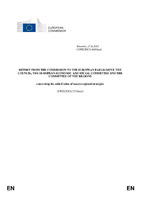Report from the Commission to the European Parliament, the Council, the European Economic and Social Committee and the Commiitte of the Regions concerning the added value of macro-regional strategies

legal document
Συγγραφέας
European Commission
Ημερομηνία
2013-06-27Προβολή/
Θεματικές επικεφαλίδες
Funding ; Organisation and governanceΠερίληψη
The macro-regional concept arose from a wish for a collective response to environmental deterioration of the Baltic Sea, and for concerted action on challenges and opportunities of that region. This resulted in the EU Strategy for the Baltic Sea Region (EUSBSR), adopted 2009. The EU Strategy for the Danube Region (EUSDR) was adopted in June 2011, and the European Council invited the Commission to present an EU Strategy for the Adriatic and Ionian Region by end 2014 subject to the evaluation of the concept.1 Other regions are considering the merits of the approach. The objective is a coordinated response to issues better handled together than separately. The two strategies aim to overcome obstacles holding up development, and unlock the potential of the regions. They seek to place issues in a multilateral setting, and to reach out beyond current EU borders to work as equals with neighbours. The approach encourages participants to overcome not only national frontiers, but also barriers to thinking more strategically and imaginatively about the opportunities available. The aim of a macro-regional strategy is to mobilise new projects and initiatives, creating a sense of common responsibility. They are an important innovation in territorial cooperation and cohesion. Nevertheless, this approach – building on a tradition of cooperation evolving from Community initiatives such as INTERREG2 – has to be judged by results, and success measured against effort required. While the approach itself enjoys a certain popularity, implementation is challenging, with improvements needed to deliver real value added in the most efficient and sustainable way.
Αριθμός σελίδων
11p.Γλώσσα
ΑγγλικάΣημείωση
COM(2013) 468 finalSWD(2013) 233 final
